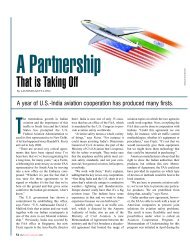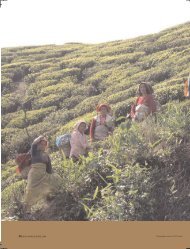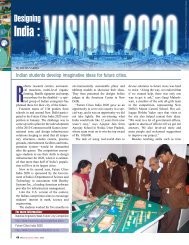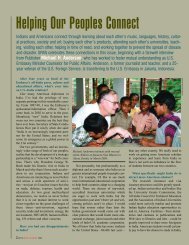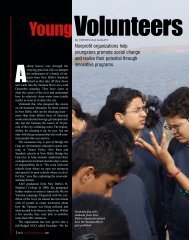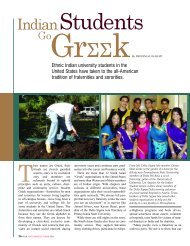Will a Genetically Modified Papaya Seed Help Indian Farmers ...
Will a Genetically Modified Papaya Seed Help Indian Farmers ...
Will a Genetically Modified Papaya Seed Help Indian Farmers ...
Create successful ePaper yourself
Turn your PDF publications into a flip-book with our unique Google optimized e-Paper software.
Tamil Nadu<br />
Agricultural<br />
University aims to<br />
eliminate a virus<br />
plaguing India’s<br />
papaya crops.<br />
In the face of soaring global food<br />
prices, more and more countries are<br />
looking to genetically modified, or<br />
GM, crops as the solution to feeding<br />
their people. India itself took another<br />
step forward in the cultivation of these<br />
crops in October 2007: the Missouri-based<br />
global seed giant, Monsanto, donated<br />
technology to Tamil Nadu Agricultural<br />
University, Coimbatore, for developing a<br />
papaya resistant to the ringspot virus,<br />
which causes India’s farmers heavy losses.<br />
8 SPAN JULY/AUGUST 2008<br />
Courtesy P. Balasubramanian<br />
Ringspot<br />
Virus Infected<br />
<strong>Will</strong> a<strong>Genetically</strong> <strong>Modified</strong><br />
<strong>Papaya</strong> <strong>Seed</strong> <strong>Help</strong> <strong>Indian</strong> <strong>Farmers</strong>?<br />
The project’s aim is to increase papaya<br />
production in India by 750 million kilograms.<br />
The new papaya, resistant to the<br />
ringspot virus, was introduced in Hawaii<br />
in the 1990s, and is now successfully cultivated<br />
there. Scientists at the Centre for<br />
Plant Molecular Biology at Tamil Nadu<br />
Agricultural University are working to<br />
develop a new papaya variety specifically<br />
to resist the virus under <strong>Indian</strong> conditions.<br />
“Hopefully, the GM papaya will be made<br />
available to papaya farmers in about four to<br />
five years,” says P. Balasubramanian, director<br />
of the center. The Government of India<br />
has approved the technology transfer.<br />
Since the early 1980s, some agricultural<br />
scientists and research institutions have<br />
seen GM plants as the answer to food<br />
shortages and malnutrition. In their view<br />
of the coming “Evergreen Revolution,”<br />
high-yielding, pest-resistant plants will<br />
boost the agricultural production of devel-
Not Infected<br />
Dr. Rajinimala (left), Nafisa Banu and<br />
Dr. K. Angappan at Tamil Nadu<br />
Agricultural University.<br />
oping countries. What Monsanto donated is a<br />
10-year, “royalty-free, non-exclusive license to<br />
use the technology to develop, identify, characterize<br />
and commercialize” the virus-resistant<br />
papaya in India, according to Bhagirath<br />
Choudhary, national coordinator of the<br />
International Service for the Acquisition of<br />
Agri-biotech Applications (ISAAA). It is a<br />
U.S.-based nonprofit organization that helps<br />
transfer biotechnologies to developing countries<br />
so poor farmers can produce more crops.<br />
ISAAA’s work is funded by charitable institu-<br />
Courtesy P. Balasubramanian<br />
How GM<br />
Crops<br />
Work<br />
Under millennia-old conventional<br />
plant breeding methods,<br />
closely related plants are<br />
cross-bred to produce new varieties<br />
that are stronger or tastier or yield<br />
larger quantities. Genetic engineering<br />
provides a more precise way of<br />
obtaining the desired traits in a plant,<br />
but it goes beyond simple recombination,<br />
introducing genes from an<br />
entirely different species, usually a<br />
bacterium, yeast or virus. This alters<br />
a plant’s genetic material, or DNA, in<br />
a way that is not possible in the wild<br />
or by using conventional techniques.<br />
In a successful experiment, the<br />
tions and government agencies, with technology<br />
and training donated by corporations. According<br />
to Choudhary, “This is an important contribution<br />
toward alleviation of poverty of small,<br />
resource-poor farmers, as papaya ringspot virus<br />
is the most devastating disease of papaya.”<br />
Clive James, a Canadian who chairs the<br />
ISAAA Board of Directors and has visited<br />
India twice in the past year to promote the<br />
development and use of biotechnology, goes<br />
even further when describing the benefits. “Our<br />
philosophy is that the aim should be to increase<br />
Courtesy ISAAA<br />
Far left: A ripe papaya<br />
infected with papaya ringspot<br />
virus.<br />
Left: Davao Solo <strong>Papaya</strong>,<br />
resistant to the virus, being<br />
grown inside a confined trial<br />
screen house in the<br />
Philippines.<br />
desirable new trait reliably appears<br />
in the plant generation after generation.<br />
Researchers usually work on<br />
improving a plant’s shelf-life, salt<br />
tolerance, drought resistance, nutrient<br />
content, pest resistance or disease<br />
resistance. To protect a papaya,<br />
a gene coding for the coat protein<br />
(the outer layer) of papaya ringspot<br />
virus is fired into the papaya’s own<br />
DNA. The virus may attack the plant<br />
but cannot multiply further because<br />
its own coat protein gene is locked<br />
up by the gene introduced in the<br />
plant. The plant is thus resistant to<br />
the virus.<br />
SPAN JULY/AUGUST 2008 9<br />
AGRICULTURE
Biotech Crops Around the World<br />
According to ISAAA, India is one of 23 countries growing GM crops. In fact, the number<br />
of developing countries planting GM crops (12) is slightly higher than the number of<br />
industrialized countries planting them (11). Twelve million farmers grow GM crops on<br />
114 million hectares worldwide. Eleven million of those farmers are resource-poor. The<br />
United States is the top grower of GM crops, with 23.32 million hectares of GM soybeans and<br />
26.96 million hectares of GM corn, or 73 percent of all U.S. corn grown. Hawaii has long<br />
served as the world’s largest outdoor biotechnology laboratory, and farmers like Albert Kung<br />
(above) are growing genetically modified papayas. At Kamiya Farm in Laie, Hawaii, Kung<br />
checks the leaves on a genetically engineered papaya tree.<br />
10 SPAN JULY/AUGUST 2008<br />
RONEN ZILBERMAN © AP-WWP<br />
Courtesy ISAAA<br />
productivity on the cropland that we have<br />
today, that is 1.5 million hectares. If you<br />
can double the production on the land that<br />
is already in agriculture, then you will not<br />
have to chop down forests and encroach<br />
on sanctuaries of biodiversity.”<br />
Some 2.5 billion kilograms of papaya<br />
are produced annually in India, in Andhra<br />
Pradesh, Assam, Bihar, Gujarat, Karnataka,<br />
Maharashtra, Manipur, Meghalaya,<br />
Orissa, Tamil Nadu, Uttar Pradesh and<br />
West Bengal. It is eaten fresh and cooked<br />
and processed into pickles, jams, candies,<br />
fruit drinks and juices. Papain, an enzyme<br />
purified from papaya latex, is extracted<br />
for export. The enzyme is used in the<br />
medicine and textile industries, breweries,<br />
leather processing and meat tenderizing.<br />
In light of the significance of<br />
papaya to the <strong>Indian</strong> economy, the introduction<br />
of a GM variety is likely to have<br />
a huge impact. Choudhary estimates that<br />
the technology promises a potential benefit<br />
of Rs. 112.5 million for India’s papaya<br />
industry.<br />
What are the conditions of the Monsanto<br />
donation? According to ISAAA’s James, it<br />
is true that corporations donate a new technology<br />
or product to potential customers to<br />
build a market, but that is not the case here.<br />
The 10-year, royalty-free period for Tamil<br />
Nadu Agricultural University “is just a<br />
project timeframe. The donation will continue.<br />
Monsanto will not come back and<br />
say, ‘You owe us some royalties now that<br />
the 10 years is over.’”<br />
James feels that fears about allergic<br />
reactions from GM foods can be<br />
addressed. He cites a case, often pointed<br />
out by opponents of GM foods as an<br />
example of what can go wrong with<br />
biotechnology, in which a gene from<br />
Brazil nut inserted in a variety of corn was<br />
found to cause an allergic reaction. James<br />
For more information:<br />
Monsanto in India<br />
http://www.monsantoindia.com/<br />
ISAAA<br />
http://www.isaaa.org/<br />
<strong>Genetically</strong> modified crops:The controversy<br />
http://encarta.msn.com/guide_gmomain/<br />
genetically_modified_crops_the_controversy.html
says the case actually shows that the system<br />
works, that a gene found to cause an<br />
allergy can be identified and removed.<br />
While hopes are high that the new<br />
papaya will solve one problem related to<br />
papaya cultivation, it’s important to point<br />
out that GM seeds aren’t meant to solve all<br />
the problems a farmer faces. Plants<br />
designed to resist one pest may still be<br />
damaged by others. Insects and viruses<br />
can evolve to overcome the resistance<br />
engineered into the plant. In such cases,<br />
farmers growing GM crops still need to<br />
spray pesticides.<br />
Laws and regulatory committees in<br />
India are still grappling with advances<br />
in genetic engineering. The <strong>Indian</strong><br />
Council of Medical Research recently<br />
drafted guidelines on the nutritional and<br />
safety assessment of GM foods (www.<br />
icmr.nic.in). The draft guidelines specify<br />
how GM foods should be tested and<br />
emphasize that they must be shown to be<br />
as non-toxic and non-allergenic as their<br />
traditional counterparts, and nutritionally<br />
superior to their non-GM equivalents if<br />
they are to be approved for commercial<br />
production in India.<br />
James suggests that the involvement<br />
of private companies, philanthropic<br />
organizations and government agencies<br />
Partnerships in Agricultural Research<br />
An agricultural biotechnology conference,<br />
co-sponsored by the <strong>Indian</strong><br />
Council of Agricultural Research and<br />
the U.S. Department of Agriculture, was<br />
held in New Delhi in March 2008, bringing<br />
together eminent <strong>Indian</strong> and American scientists<br />
and researchers in the field of agricultural<br />
biotechnology.<br />
The conference on “Harnessing the<br />
Benefits of Biotechnology” provided a platform<br />
for experts from both countries to discuss<br />
their strategies for increased research<br />
collaboration and public-private partnerships<br />
that will result in the improvement of<br />
agricultural crops to benefit farmers and<br />
working together to improve crop yields<br />
can enhance sustainability. “I think in<br />
many developing countries there is often<br />
the view that the private sector is a neg-<br />
Sekhar Natarajan, chairman of Monsanto<br />
India (left); Clive James, chairman and<br />
founder of ISAAA, and P. Balasubramanian,<br />
director of the Centre for Plant Molecular<br />
Biology at Tamil Nadu Agricultural<br />
University, celebrate the virus-resistant<br />
papaya technology transfer in October 2007.<br />
Courtesy P. Balasubramanian<br />
consumers.<br />
Many <strong>Indian</strong> and American institutions<br />
participated in the workshop, including the<br />
<strong>Indian</strong> Institute of Technology, Kanpur, the<br />
National Research Centre on Plant Biotechnology,<br />
the <strong>Indian</strong> Agricultural Research<br />
Institute, Punjab Agricultural University, the<br />
Donald Danforth Plant Science Center,<br />
Virginia Polytechnic Institute and State<br />
University, Washington University and the<br />
University of Missouri.<br />
For more information:<br />
http://www.icar.org.in/<br />
http://www.usda.gov/wps/portal/usdahome<br />
ative force, rather than a positive one,”<br />
says James. He argues that government<br />
monopolies are no different than corporate<br />
ones, and are sometimes worse. “So<br />
a better working relationship between<br />
the two is…get the best of the private<br />
sector, best of the public sector together<br />
and build new programs where they have<br />
roles that reflect their comparative<br />
advantages.” This is ISAAA’s role, he<br />
says. “The best contribution that they<br />
[the private sector] can make is technology,<br />
which has cost millions to develop,<br />
that can be used for the alleviation of<br />
poverty and hunger.”<br />
Meanwhile, papaya continues to rank<br />
high in research objectives. Choudhary<br />
says, “<strong>Papaya</strong> technology is listed as a priority<br />
technology under the Agricultural<br />
Knowledge Initiative between the United<br />
States and India. The ISAAA is already<br />
implementing the ringspot virus-resistant<br />
papaya technology donated by Monsanto<br />
and improving the shelf life of papaya<br />
using a delayed ripening technology<br />
donated by Syngenta through the <strong>Papaya</strong><br />
Biotechnology Network of Southeast<br />
Asia.”<br />
Because of the economic significance<br />
of the crop in India, the development of<br />
GM papaya is sure to be closely watched<br />
by all stakeholders.<br />
Please share your views on this article.<br />
Write to editorspan@state.gov<br />
SPAN JULY/AUGUST 2008 11





